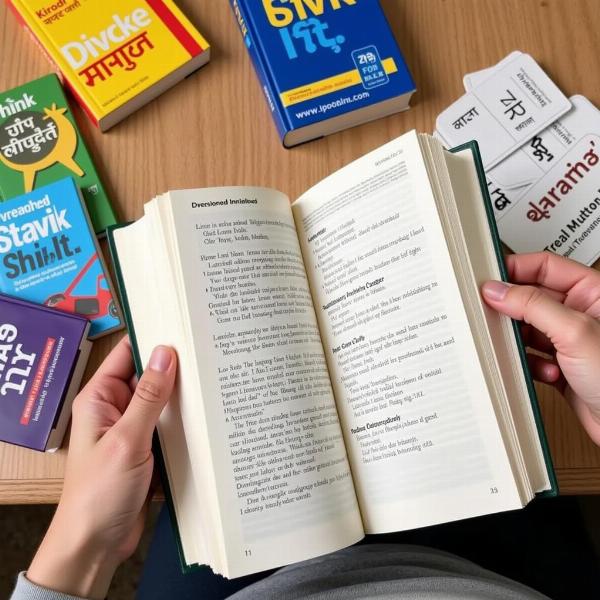Understanding the meaning of “topics” in Hindi is crucial for effective communication and navigating various contexts. Whether you’re engaging in casual conversations, academic discussions, or professional settings, knowing the appropriate Hindi equivalent for “topics” can significantly enhance your understanding and expression. This guide explores the various Hindi translations of “topics,” considering their nuances and appropriate usage in different situations.
Exploring Hindi Translations for “Topics”
The Hindi language offers several ways to express the English word “topics,” each carrying slightly different connotations and suitable for specific contexts. Let’s delve into some of the most common translations:
-
Vishay (विषय): This is perhaps the most common and versatile translation for “topics.” Vishay encompasses a broad range of subjects and is suitable for both formal and informal contexts. For example, “What are the topics of discussion today?” can be translated as “Aaj charcha ke vishay kya hain? (आज चर्चा के विषय क्या हैं?)”
-
Mudda (मुद्दा): This word implies a specific point or issue being discussed. It’s often used in the context of debates or arguments. For instance, “The main topic of the debate was…” translates to “Bahas ka mukhya mudda tha… (बहस का मुख्य मुद्दा था…)”
-
Baat (बात): In casual conversations, “baat” can be used to refer to the topic of conversation. However, it’s less formal than “vishay” or “mudda.” For example, “Let’s change the topic” can be casually phrased as “Baat badalte hain (बात बदलते हैं).”
-
Charcha ka Vishay (चर्चा का विषय): This phrase literally translates to “topic of discussion” and is suitable for formal settings. It emphasizes the subject matter being discussed.
-
Samasya (समस्या): When the topic involves a problem or issue, “samasya” is the appropriate translation. For example, “The topic of pollution” could be translated as “Pradushan ki samasya (प्रदूषण की समस्या).”
Choosing the Right Word: Context Matters
Selecting the correct Hindi word for “topics” depends heavily on the context. Using “mudda” in a casual conversation might sound too formal, while using “baat” in an academic setting might be inappropriate. Therefore, understanding the nuances of each word is crucial for effective communication.
Formal Contexts
In formal settings like academic discussions, presentations, or official meetings, using “vishay” or “charcha ka vishay” is generally preferred. These terms maintain a level of formality and clarity appropriate for such situations.
Informal Contexts
In casual conversations or informal discussions, using “baat” can be appropriate. However, if the topic is a serious issue, using “mudda” or “samasya” might be more fitting.
Examples of “Topics” in Different Scenarios
Let’s look at some examples to illustrate the appropriate usage of these Hindi words in different scenarios:
-
In a classroom: “Aaj hum ‘Bharatiya Itihaas’ ke vishay par charcha karenge. (आज हम ‘भारतीय इतिहास’ के विषय पर चर्चा करेंगे.)” – Today, we will discuss the topic of Indian History.
-
In a business meeting: “Agle mudde par chalte hain. (अगले मुद्दे पर चलते हैं.)” – Let’s move on to the next topic.
-
Among friends: “Kal raat humne kya baat ki thi? (कल रात हमने क्या बात की थी?)” – What were we talking about last night?
-
During a debate: “Is bahas ka mukhya mudda paryavaran sanrakshan hai. (इस बहस का मुख्य मुद्दा पर्यावरण संरक्षण है.)” – The main topic of this debate is environmental conservation.
Mastering “Topics Meaning in Hindi”
Understanding the various Hindi translations for “topics” enhances your ability to communicate effectively in diverse situations. By choosing the right word based on the context and nuance, you can express yourself clearly and accurately, avoiding potential misunderstandings and enhancing your overall communication skills.
 Mastering Hindi Vocabulary
Mastering Hindi Vocabulary
Conclusion
Navigating the nuances of “topics meaning in Hindi” empowers you to engage in more meaningful and accurate communication. By mastering the different translations and their appropriate usage, you can confidently navigate both formal and informal contexts, enriching your interactions and fostering deeper understanding. Remember to consider the context, formality, and specific meaning you wish to convey when choosing the right Hindi word for “topics.”
FAQ
-
What is the most common Hindi word for “topics”? The most common Hindi word for “topics” is “vishay (विषय).”
-
When should I use “mudda” instead of “vishay”? “Mudda” is more appropriate when referring to a specific point or issue, often in the context of debates or arguments.
-
Is it okay to use “baat” for “topic” in formal settings? While “baat” can refer to the topic of conversation, it’s generally more suitable for informal contexts.
-
What if the topic is a problem or issue? In such cases, “samasya (समस्या)” is the most appropriate translation.
-
How can I improve my understanding of Hindi word nuances? Immersing yourself in the language through reading, listening, and speaking will help you grasp the subtle differences between words.
Meaning-Hindi.in is your one-stop solution for all your Hindi translation needs. We offer a comprehensive range of translation services, from business and legal documents to technical manuals and website localization. Our team of expert translators ensures accuracy, cultural sensitivity, and timely delivery. Contact us today at [email protected] or +91 11-4502-7584 to discuss your translation requirements. Meaning-Hindi.in offers professional translation services for business, legal, technical, website, educational, and specialized content. We prioritize accuracy, cultural sensitivity, and efficient delivery for all your Hindi translation needs. Contact us today for a personalized solution!